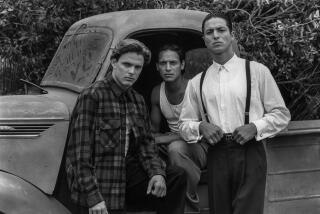To the Red Cross, His Habit Makes Him a Blood Brother
- Share via
There’s a little bit of Joe Herzer in a lot of Angelenos.
Since he was 18 years old, Herzer, a retired Los Angeles County sheriff’s deputy, has journeyed to the local American Red Cross office about every six weeks to donate blood.
He has never really thought much about it. No big deal . . . just something he got in the habit of doing.
But pint by pint, year after year, he has accumulated an astounding record.
Over the course of nearly 50 years, he has donated 41 gallons of Type O negative blood--and that is not including a few stray gallons he has donated while in Ventura County, Washington state, Ohio and even Japan.
He is the top blood donor in Los Angeles and Orange counties, although for Herzer, it is a distinction he could not care less about.
He has never taken anything for his donation and he has not kept track of how much blood he has donated.
He had no idea he was at the top of the donor list until the American Red Cross did a search of its records on a request from The Times. He was surprised that anyone cared.
“I never gave it a thought,” said the 64-year-old Herzer as he sat in his Simi Valley home. *
In a world that often centers on “me first,” the story of Joe Herzer is one of those simple tales of a regular guy going about his business in his own way--and somewhere along the line accomplishing something great.
Herzer, a graying grandfather with an easy laugh, said he got started donating blood because of his father, a school building inspector who, like millions of others, heeded the call for blood donations during World War II. “He just got in the habit of doing it,” Herzer said.
Blood donation was rarely a topic of discussion among family members. It was just one of many things they did at the time to support the war effort: They saved their cooking grease, they started a small vegetable garden, they saved their toothpaste tubes so the metal in them could be melted down, they gave blood every month or so.
Herzer was too young at the time to donate, but a year after the war ended, he started going down to the blood bank on his own. Except for the three years he served in the Army, Herzer has been donating ever since.
He has no explanation for why he has been so regular in donating blood except that after all these years, it has become a part of his life.
But it appears to mirror his approach to life in general--slow, but sure.
Since he was 10, he has been collecting magicians’ paraphernalia and gradually has built up a respectable collection. He has the first magic book he ever bought--the Encyclopedia of Card Tricks. He rummaged through the shelves of magic books packed into his study in search of the first deck of trick cards he bought more than 50 years ago. “Got it around here somewhere,” he said. *
Herzer’s donation has been important not only because of the amount of blood he has given, but also because of the type of blood--O negative.
Of the eight major blood types, only O negative can be given to anyone regardless of his or her blood type. Because of its universal acceptance, O negative is important in emergencies when there may not be enough time to determine a patient’s blood type.
Out of the total population, only 7% are O negative. Considering that only about 4% of people regularly give blood, the number of O negative donors is minuscule.
“When you talk about these numbers, it’s a pretty staggering task to find donors,” said Cheryle Babbitt, director of blood services for the American Red Cross in Southern California.
Despite Southern California’s booming population, the number of donors has been slowly dropping over the years.
The Red Cross collects about 250,000 pints of blood a year. It has to import another 50,000 pints from other parts of the country to make up the shortfall.
Babbitt said that many of the most consistent donors, like Herzer, are part of the generation that lived through World War II and still remember the sense of people working together for a common cause.
“They became donors when it was a real patriotic thing to do,” she said. “They’re contributors. Look at who volunteers for things now. They are really the folks who take care of their communities.”
The younger generation has been less willing to participate. The unfounded fear of contracting AIDS by giving blood also has hurt the blood banks, Babbitt said. *
For Herzer, the reasons why people give or do not give blood mean little. He has never made a big deal out of his contribution and rarely talks about it. None of his children nor his siblings give blood, although his wife has been donating with him for the past decade or so.
As for his own blood giving, Herzer said that he has had to slow down a bit as he has grown older, but he has no intention of quitting.
“Oh . . . I’ll keep giving until they throw me out,” he said.
More to Read
Sign up for Essential California
The most important California stories and recommendations in your inbox every morning.
You may occasionally receive promotional content from the Los Angeles Times.














